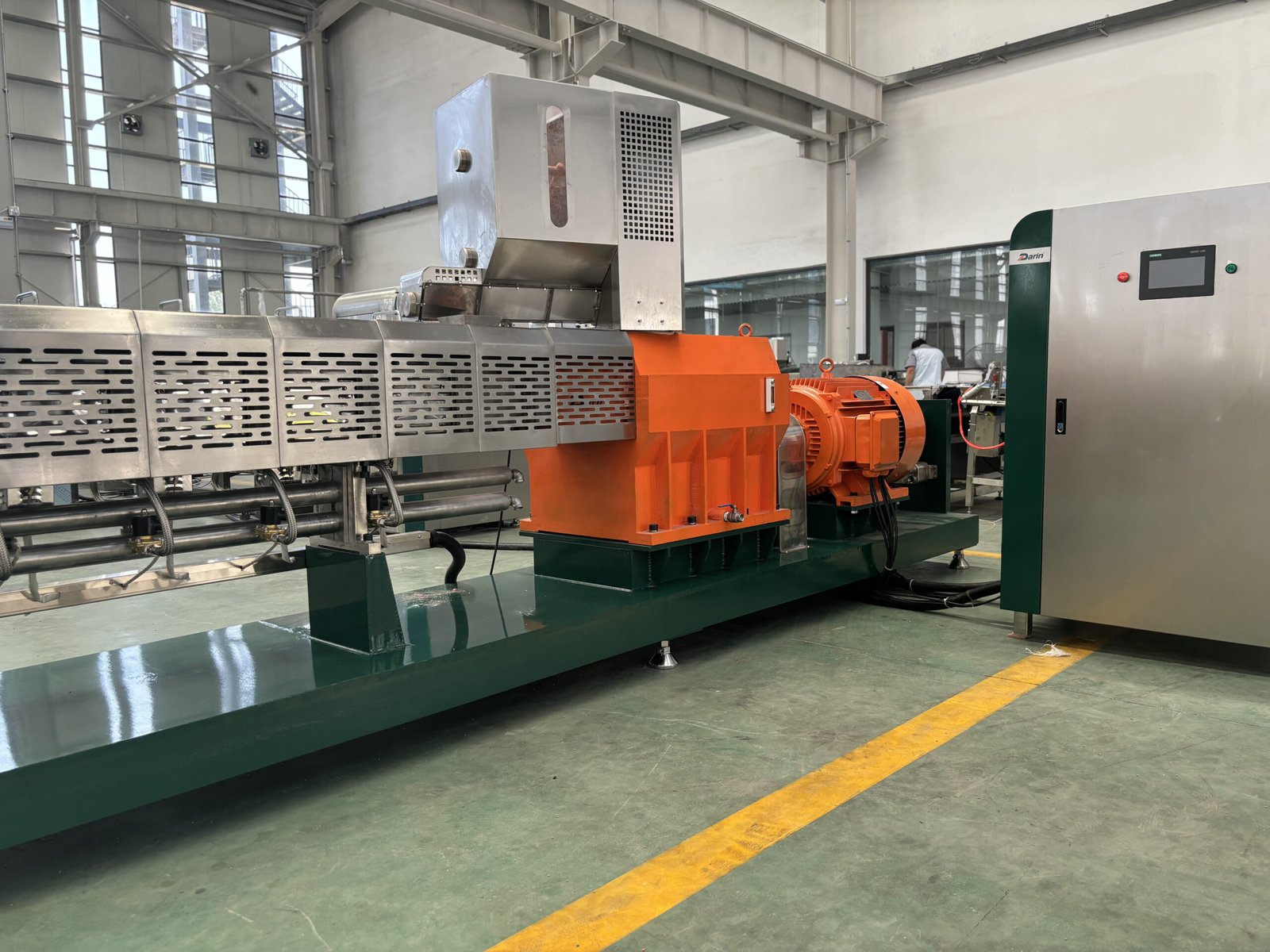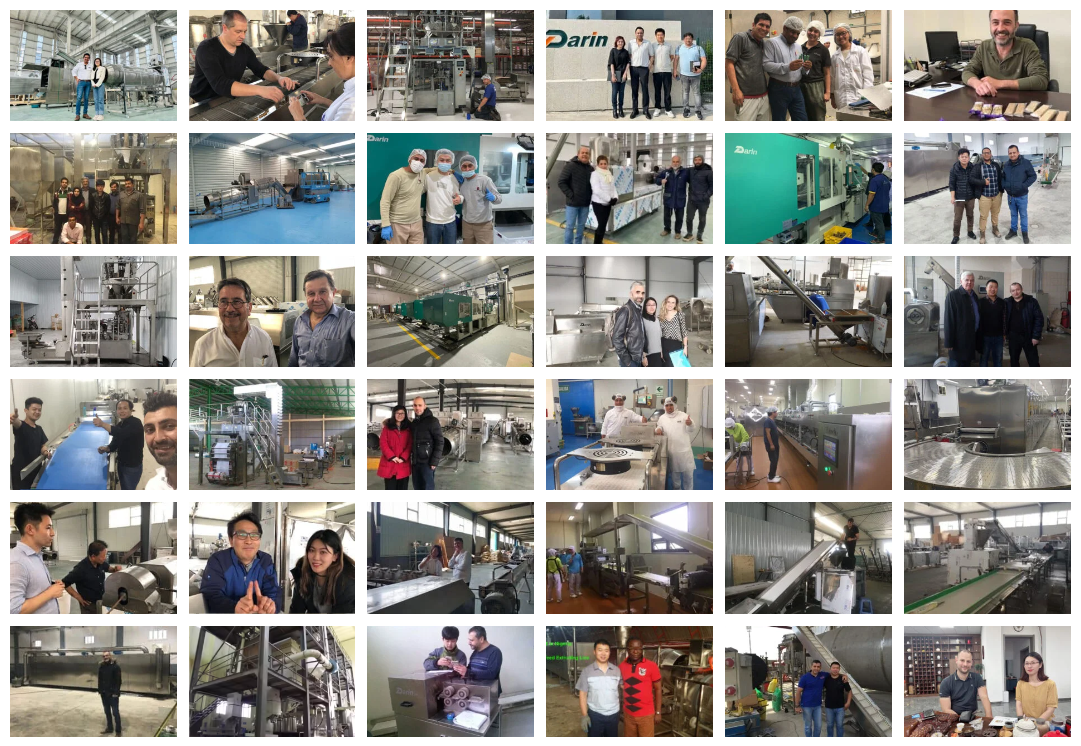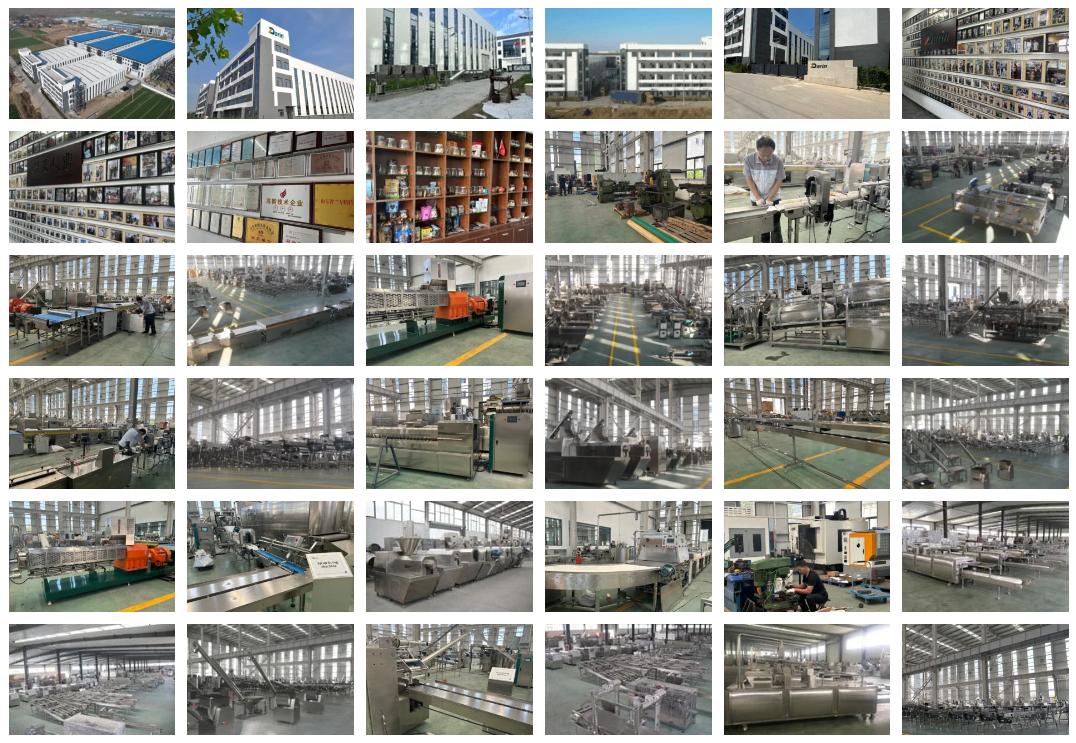
The choice of a pet food extruder is crucial for manufacturers aiming to scale production efficiently. Yet, one of the most commonly overlooked—but critically important—factors is the size and footprint of the extruder. A misjudgment here can lead to major layout challenges, logistical inefficiencies, and even costly facility modifications. Businesses often underestimate how much space a fully operational extrusion system occupies, including feeding, preconditioning, control systems, and post-extrusion elements like dryers or coaters. Fortunately, understanding the typical dimensions, layout requirements, and configuration variations of modern pet food extruders can help you avoid these mistakes. In this article, we’ll provide a detailed breakdown of the size and footprint of various pet food extruders, from small-scale pilot machines to industrial high-capacity models.
The size and footprint of a pet food extruder depend on its production capacity, configuration (single or twin-screw), and auxiliary equipment, but typically range from 3 to over 20 meters in length, with widths from 1.5 to 4 meters, and ceiling height requirements between 2.5 to 6 meters. Industrial systems may require floor space of 40–150 square meters, including safety and access clearance.
If you're planning a new facility or upgrading an existing one, understanding the actual space requirements for a pet food extrusion line is essential for smooth installation, efficient operation, and future scalability. Let's dive deeper into what these dimensions mean in practical terms, and how to select or adapt equipment to match your production goals.
Pet food extruder machines are compact enough to fit in any commercial kitchen.Falso
Most pet food extruders, especially industrial models, require substantial floor space due to their length, auxiliary components, and safety clearance needs.
Understanding the Footprint of a Pet Food Extruder
1. Types of Extruders and Their Dimensions
Pet food extruders are generally classified by screw configuration (single or twin-screw), and their output capacity. Here is a basic breakdown:
| Tipo de extrusora | Typical Length (m) | Width (m) | Height (m) | Floor Area Required (m²) | Production Capacity (kg/h) |
|---|---|---|---|---|---|
| Pilot-Scale Single Screw | 3–5 | 1.5 | 2.5–3.5 | 10–20 | 50–200 |
| Pilot-Scale Twin Screw | 4–6 | 2 | 2.5–3.5 | 15–25 | 100–400 |
| Medium-Scale Twin Screw | 6–10 | 2.5–3 | 3–4 | 30–60 | 300–1000 |
| Industrial Twin Screw | 12–20+ | 3–4 | 4–6 | 80–150+ | 1000–8000+ |
These are only estimates and can vary depending on:
- Manufacturer design
- Optional attachments like preconditioners, feeders, coolers, and control panels
- Inclusion of automated bagging or conveying systems
A key point: footprint is not limited to the extruder itself. Pre- and post-extrusion equipment adds significantly to the total required space.
2. Layout Planning: Horizontal vs. Vertical Flow
When planning the installation footprint of an extruder, it's important to consider the line layout:
- Horizontal layout: More common in large industrial factories. Equipment is spread across a large area, typically requiring greater square meterage but easier for maintenance.
- Vertical layout: Stacked systems, often used when floor space is limited but ceiling height is ample. These systems may include mezzanines or elevated platforms.
| Tipo de diseño | Pros | Contras |
|---|---|---|
| Horizontal | Easy maintenance, better visibility, scalable | Requires more floor space |
| Vertical | Saves floor space, shorter conveying lines | Higher installation cost, limited accessibility |
3. Real-World Case Study: 3T/H Pet Food Line
Let’s consider a 3 tons/hour (3,000 kg/h) twin-screw extrusion system installed by a top-tier manufacturer:
- Extruder Length: 12 meters
- Width with Control Panels and Feeders: 3.5 meters
- Height with Preconditioner: 4.5 meters
- Post-extrusion Dryer: 6 meters long
- Coating + Cooling Section: 4 meters long
- Total Line Length: ~22–25 meters
- Total Footprint (with walking space): ~100–120 m²
- Ceiling Height Needed: Minimum 5 meters for safe clearance
This setup is typical in medium to large-scale pet food plants producing kibble for dogs and cats.
4. Auxiliary Equipment and Space Considerations
Extruders don’t work alone. To function optimally, the line includes:
| Componente | Función | Space Impact |
|---|---|---|
| Feeder/Hopper | Material feeding | +1–2 m² |
| Preacondicionador | Hydration and heat treatment | +2–3 m² |
| Extrusora | Mixing, shearing, shaping | Main unit |
| Cortadora | Size adjustment | Minimal additional |
| Secadora | Eliminación de la humedad | +6–8 m² |
| Recubridor | Flavor/fat application | +2–3 m² |
| Enfriador | Temperature normalization | +3–5 m² |
| Transportadores | Interconnect machines | Linearly placed along the path |
Safety zones, operator walkways, and maintenance clearance must also be planned (add at least 25% extra space).
5. Electrical and Ventilation Considerations
Pet food extrusion facilities must accommodate:
- Dedicated power supply areas (control cabinets can occupy 2–5 m²)
- Ventilation and dust control systems, especially in drying zones
- Noise barriers or isolated operation rooms in large-scale operations
All these influence not just space allocation but also facility design.
6. Scaling the Line Up or Down
Modularity is key when considering space for expansion.
| Escenario | Recommended Setup | Space Planning Tip |
|---|---|---|
| R&D/Startup | Pilot twin-screw with mobile components | Allocate 20 m² minimum |
| PYME en crecimiento | 1–2 T/H twin-screw line | 50–80 m² + expansion buffer |
| Mass Production | 5–10 T/H continuous line | 120–200 m² |
Modular extruders offer expandable configurations to adapt with demand, but only if space was pre-allocated at installation.
7. CAD Planning and Layout Optimization
It is standard for pet food extrusion suppliers to provide CAD drawings or even 3D simulations of the equipment layout. This is not just helpful—it’s critical for:
- Confirming space availability
- Aligning with HVAC, power, and water lines
- Ensuring compliance with food safety regulations and operator safety
Manufacturers also offer site visits for footprint assessment and layout optimization.
8. Summary Comparison Table
| Production Size | Approx. Output | Footprint Estimate | Ideal User |
|---|---|---|---|
| Bench-top / Lab | <100 kg/h | <10 m² | R&D labs |
| Small-Scale Pilot | 100–400 kg/h | 10–25 m² | New brands |
| Mediana escala | 500–2000 kg/h | 50–100 m² | Growing SMEs |
| Large Industrial | >3000 kg/h | 100–200 m² | Established manufacturers |
Conclusión
Entendiendo el size and footprint of a pet food extruder is more than just a logistics issue—it’s foundational to operational success, future growth, and compliance. Whether you're working in a pilot facility or setting up a 10,000-square-meter pet food plant, selecting the right extruder and planning for its full spatial needs—including auxiliary equipment and safety clearances—can ensure efficient workflow, lower installation costs, and scalable success. Always work with a trusted equipment supplier to get exact machine specs, layout recommendations, and customized CAD plans.
Contact Us to Get the Perfect Fit for Your Facility
If you’re planning to purchase or upgrade a pet food extruder and want precise footprint planning tailored to your site, contact our engineering team. We provide customized layout design, equipment specificationsy installation consultation to ensure your extrusion line is optimized for performance and space.
Let us help you maximize your space and productivity—reach out today!

PREGUNTAS FRECUENTES
Q1: What is the typical size of a pet food extruder?
A1: The size of a pet food extruder can vary depending on production capacity and model. Small-scale extruders may measure around 2–3 meters in length, while industrial extruders can exceed 5–10 meters. The height ranges from 1.5 to 3 meters. Width depends on the design but is usually between 1 to 2.5 meters. Manufacturers provide detailed technical specifications for each model.
Q2: How much floor space does a pet food extruder require?
A2: Floor space requirements vary, but small extruders can occupy 10–20 square meters. Medium to large-scale industrial systems may need 50–150 square meters, especially when considering auxiliary equipment like feeders, dryers, and coolers. It’s essential to account for maintenance access, ventilation, and workflow layout when planning installation.
Q3: What factors influence the footprint of a pet food extruder?
A3: Key factors include production capacity (kg/hr), design configuration (single vs. twin-screw), auxiliary equipment, and whether the system is modular or integrated. Larger output capacities typically require longer barrels, larger motors, and more extensive supporting systems, increasing the total footprint.
Q4: How can I choose the right size extruder for my facility?
A4: Start by assessing your target production volume, available floor space, and power supply. Consult with manufacturers or engineers to match an extruder size that fits your operational goals and physical constraints. Modular systems are available for scalability and flexibility.
Q5: Does the size of the extruder affect pet food quality?
A5: While size influences throughput and energy efficiency, product quality is more directly impacted by screw configuration, die design, moisture control, and processing parameters. However, larger extruders offer better control systems and automation features that can improve consistency and quality.

Referencias
- Pet Food Extrusion Process Overview - https://www.extru-techinc.com/pet-food-extrusion/ - Extru-Tech Inc.
- Twin-Screw Extruder Design & Applications - https://www.clextral.com/twin-screw-technology/ - Clextral
- Selecting the Right Extruder for Your Pet Food Plant - https://www.feedstrategy.com/processing-equipment/extruders/ - Estrategia de alimentación
- Pet Food Production Line Specifications - https://www.loyalfoodmachine.com/pet-food-production-line/ - Industrial Leal
- Extrusion Systems for Pet Food - https://www.buhlergroup.com/global/en/products/solutions/pet-food-processing.htm - Grupo Bühler
- Factors Affecting Extruder Size - https://www.readingbakery.com - Sistemas de panadería de Reading
- Industrial Extruder Systems – Size and Capacity - https://www.andritz.com - ANDRITZ Group
- Pet Food Processing Equipment Insights - https://www.petfoodindustry.com/topics/296-equipment - Industria de alimentos para mascotas
- Dry Pet Food Extrusion Technology - https://www.pavan.com/en/food-technologies/pet-food/ - Pavan Group
- Extrusion Equipment Layout Planning - https://www.fpsinc.com - Food Processing Solutions Inc.










